Common Snow Melting Agents and Their Pros & Cons
Snow melting agents (de-icing chemicals) are widely used to prevent ice accumulation on roads, sidewalks, and runways. Below is an overview of the most common types, along with their advantages and disadvantages.
1. Sodium Chloride (Rock Salt, NaCl)
Pros:
✅ Cost-effective – The cheapest and most widely available de-icer.
✅ Fast-acting – Works well at temperatures down to -9°C (15°F).
✅ Easily spreadable – Can be applied in solid or pre-wetted (brine) form.
Cons:
❌ Corrosive – Damages concrete, steel (bridges, vehicles), and vegetation.
❌ Environmental harm – Increases soil salinity, harms aquatic life, and contaminates groundwater.
❌ Limited effectiveness – Fails in extreme cold (below -9°C / 15°F).
Best for: Highways, urban roads (where cost is a priority).
2. Calcium Chloride (CaCl₂)
Pros:
✅ Works in extreme cold – Effective down to -29°C (-20°F).
✅ Exothermic reaction – Releases heat, melting ice faster.
✅ Less corrosive than NaCl – Still harmful but less damaging than rock salt.
Cons:
❌ More expensive – Costs 2-3 times more than NaCl.
❌ Moisture-absorbing – Can become sticky and leave residues.
❌ Still corrosive – Damages metal and concrete over time.
Best for: Airports, critical infrastructure, very cold regions.
3. Magnesium Chloride (MgCl₂)
Pros:
✅ Less corrosive than NaCl & CaCl₂ – Gentler on infrastructure.
✅ Effective at low temps – Works down to -15°C (5°F).
✅ Pre-wetting capability – Often used as a brine for pre-treatment.
Cons:
❌ Higher cost – More expensive than rock salt.
❌ Environmental concerns – Can harm plants and aquatic ecosystems.
❌ Residue buildup – Leaves slippery film if overused.
Best for: Bridges, parking lots, environmentally sensitive areas.
4. Potassium Acetate (CH₃COOK) & Calcium Magnesium Acetate (CMA)
Pros:
✅ Environmentally friendly – Biodegradable, non-corrosive.
✅ Safe for concrete & vegetation – Preferred for eco-sensitive zones.
✅ Works at low temps – Effective down to -30°C (-22°F) (Potassium Acetate).
Cons:
❌ Very expensive – 10-20x the cost of NaCl.
❌ Slower melting action – Not ideal for rapid ice removal.
❌ Limited availability – Mostly used in airports and high-priority areas.
Best for: Airports, eco-sensitive areas, historic structures.
5. Urea (NH₂CONH₂)
Pros:
✅ Less corrosive – Safer for metals and concrete than salts.
✅ Fertilizer properties – Can benefit soil (in small amounts).
Cons:
❌ Nitrogen pollution – Causes algal blooms in water bodies.
❌ Limited effectiveness – Works only down to -7°C (20°F).
❌ Slow action – Takes longer to melt ice.
Best for: Limited use in pedestrian walkways (not ideal for roads).
6. Sand & Abrasives
Pros:
✅ No chemical impact – Safe for environment and infrastructure.
✅ Provides traction – Helps prevent slipping even if ice doesn’t melt.
Cons:
❌ Does not melt ice – Only improves grip.
❌ Cleanup required – Accumulates and clogs drains.
❌ Short-term solution – Needs frequent reapplication.
Best for: Supplementary use with other de-icers.
Comparison Table
| De-icer | Min. Temp. (°C) | Cost | Corrosiveness | Environmental Impact | Best Use Case |
|---|---|---|---|---|---|
| NaCl (Rock Salt) | -9°C (15°F) | $ | High | High | Roads, highways |
| CaCl₂ (Calcium Chloride) | -29°C (-20°F) | $$$ | Medium | Medium | Airports, extreme cold |
| MgCl₂ (Magnesium Chloride) | -15°C (5°F) | $$ | Low-Medium | Medium | Bridges, parking lots |
| Potassium Acetate | -30°C (-22°F) | $$$$ | Very Low | Low | Airports, eco zones |
| CMA | -7°C (20°F) | $$$$ | Very Low | Low | Historic sites |
| Urea | -7°C (20°F) | $$ | Low | Medium (Nitrogen) | Sidewalks |
| Sand | N/A (traction only) | $ | None | Low (but messy) | Supplemental use |
Conclusion: Which to Choose?
- Budget & high volume? → Sodium Chloride (NaCl)
- Extreme cold? → Calcium Chloride (CaCl₂)
- Eco-friendly & non-corrosive? → Potassium Acetate or CMA
- Need traction without melting? → Sand
Each de-icer has trade-offs between cost, effectiveness, and environmental impact. The best choice depends on the specific application and local conditions.






